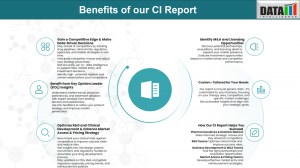Uveal Melanoma (UM): Charting the Future of Innovation in a Rare Eye Cancer | Competitive Intelligence
Uveal Melanoma enters a new era with novel therapies like KIMMTRAK and HEPZATO, as next-gen treatments aim to overcome immune evasion and metastasis.
Unlike cutaneous melanoma, UM is biologically distinct, with a low tumor mutational burden and immune-evasive behavior, rendering traditional immunotherapies largely ineffective, until recently.
Download CI Sample Report: https://datamintelligence.com/strategic-insights/sample/uveal-melanoma
Approved Therapies for Uveal Melanoma
1. KIMMTRAK® (tebentafusp-tebn) – Immunocore
• FDA Approval: 2022
• Mechanism: Bispecific T-cell receptor therapy targeting gp100 peptide-HLA-A*02:01 and CD3 on T-cells.
• Indication: HLA-A*02:01-positive adult patients with metastatic or unresectable UM.
• Impact: KIMMTRAK marked a paradigm shift, being the first and only immunotherapy approved for UM, demonstrating a median OS of 21.7 months vs. 16 months with the investigator’s choice of treatment.
2. HEPZATO KIT™ (melphalan for percutaneous hepatic perfusion) – Delcath Systems
• FDA Approval: 2023
• Mechanism: Delivers high-dose melphalan directly to the liver, minimizing systemic toxicity.
• Indication: Adult patients with unresectable hepatic-dominant metastatic UM.
• Impact: Addresses the liver-centric nature of UM metastasis; approved under an interventional chemoperfusion approach.
Emerging Therapies in the Pipeline
With current treatments limited by HLA-A*02:01 restriction or organ-specific delivery, multiple companies are advancing diverse modalities to improve efficacy, access, and long-term outcomes:
Pipeline Therapies Under Clinical Development (Selected)
1. Tebentafusp (KIMMTRAK) – Immunocore – Phase III
• Now being evaluated in Phase III adjuvant settings to prevent relapse after primary tumor treatment.
2. Belzupacap sarotalocan – Aura Biosciences – Phase III
• A photosensitizer that activates in tumor cells to generate reactive oxygen species. Phase III trials are focused on primary UM to prevent progression.
3. Darovasertib – IDEAYA Biosciences – Phase III
• A PKC inhibitor is entering planned Phase III trials for neoadjuvant use, aiming to shrink tumors pre-surgery and target micrometastases early.
4. RP2 (Oncolytic HSV expressing anti-CTLA-4) – Replimune – Phase II/III
• A next-gen viral immunotherapy combined with nivolumab in Phase II/III, targeting checkpoint-naïve metastatic UM.
5. Roginolisib – iOnctura – Phase II
• A PI3K delta inhibitor under Phase II development for metastatic UM patients, potentially modulating the tumor microenvironment.
6. Cifurtilimab (SEA-CD40) – Pfizer – Phase II
• A CD40 agonist monoclonal antibody, aiming to promote APC activation and T-cell priming.
7. [225Ac]-FPI-1434 – Fusion Pharmaceuticals/AstraZeneca – Phase I/II
• A radioligand therapy targeting IGF-1R, delivering Actinium-225 directly to UM cells. Early-phase trials are ongoing.
8. ONM-501 – OncoNano Medicine – Phase I
• A dual-activating STING agonist in Phase I for recurrent UM, designed to stimulate innate immunity and tumor inflammation.
9. 225Ac-MTI-201 – Modulation Therapeutics – Phase I
• A novel alpha radiotherapy agent targeting MC1R, a melanocytic receptor prevalent in UM cells.
10. Nelitolimod (SD-101) – TriSalus Life Sciences – Phase I
• A TLR9 agonist developed for hepatic metastatic UM, delivered using pressure-enabled infusion.
Market Shifts and Strategic Trends
Key Market Shifts
• From palliative to curative intent: Therapies are moving toward adjuvant and neoadjuvant applications, aiming for early disease control.
• Immune system re-engagement: Strategies targeting innate immunity (e.g., STING, TLR9, CD40) are gaining traction to overcome UM’s immune desert phenotype.
• Precision delivery: Advances in radioligand and liver-targeted systems are enabling focused tumor killing while preserving systemic health.
• Broadening eligibility: With KIMMTRAK’s restriction to HLA-A*02:01 (~45–50% of patients), the pipeline aims for broader population inclusion.
Book Free CI Consultation Call: https://datamintelligence.com/strategic-insights/ci/uveal-melanoma
Target Opportunity Profile (TOP)
To outcompete approved therapies, emerging drugs must demonstrate:
• Broader patient applicability (not restricted by HLA status)
• Superior survival benefit and/or organ-specific control
• Better safety and tolerability
• Mechanistic novelty (e.g., STING/CD40 vs. TCR)
• Convenient delivery (oral, SC, or IV over hepatic perfusion)
• Combination readiness with ICIs, RLTs, or biologics
Conclusion: UM at an Inflection Point
Uveal melanoma has long been underserved with limited treatment options and poor metastatic outcomes. With KIMMTRAK paving the way and HEPZATO offering a liver-specific solution, the stage is now set for next-generation immunotherapies, kinase inhibitors, and precision delivery platforms to transform outcomes.
The future of UM treatment lies in combining innovation, patient-centric accessibility, and mechanistic breadth. The pipeline is rich, but to succeed, emerging candidates must not only be novel but also strategically superior to existing benchmarks.
Read Related CI Reports:
1. Messenger RNA mRNA Vaccine | Competitive Intelligence2
2. Idiopathic Pulmonary Fibrosis | Competitive Intelligence3
Sai Kumar
DataM Intelligence 4market Research LLP
+1 877-441-4866
sai.k@datamintelligence.com
Visit us on social media:
LinkedIn
X
1 https://datamintelligence.com/strategic-insights/uveal-melanoma
2 https://www.datamintelligence.com/strategic-insights/messenger-rna-mrna-vaccine
3 https://www.datamintelligence.com/strategic-insights/idiopathic-pulmonary-fibrosis-ipf

